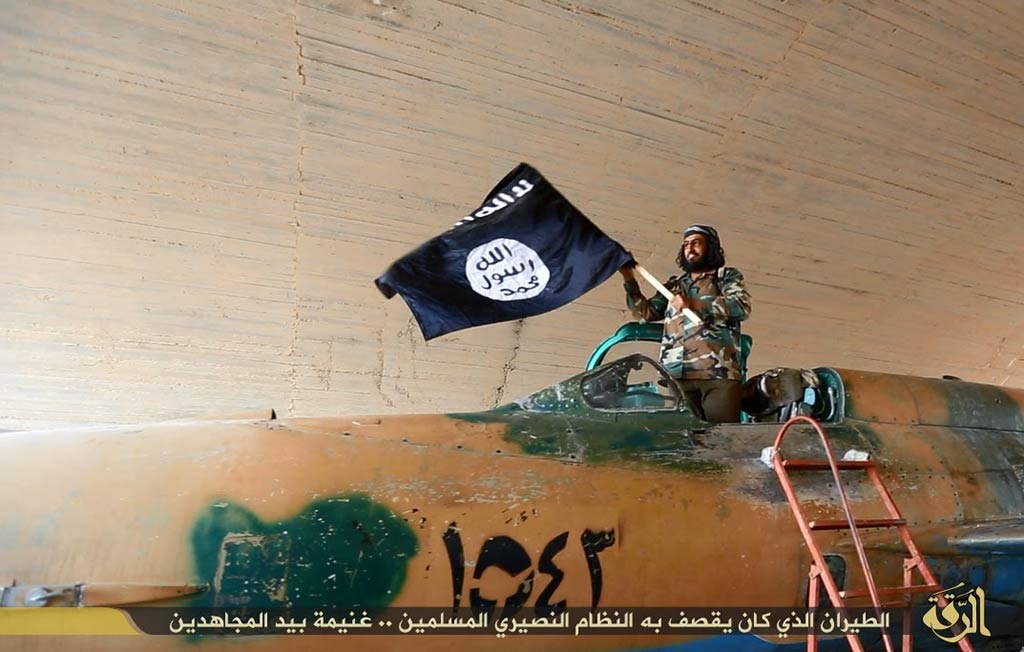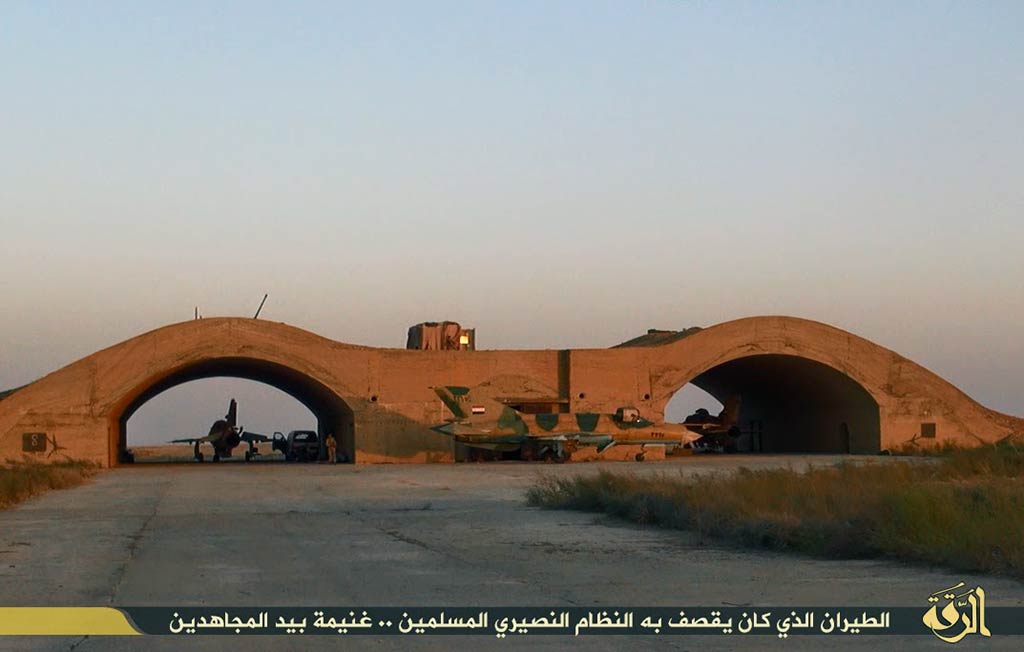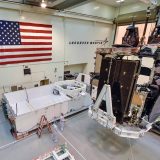The Islamic State is Air Force preparing
Islamic State Training Pilots in Military Jets
The Syrian Observatory for Human Rights (SOHR) reported today that ex-Syrian combat aircraft have been seen off from an airstrip controlled by the Islamic State. This has sparked speculation about whether or not we’re seeing the birth of the brand-new Islamic State Air Force.
(By happy coincidence, it would share an acronym — ISAF — with the NATO peacekeeping force in Afghanistan.)

ID/ISIS release a video in which it showed captured Syrian Air Force MiG-21 in Tabqa Airbase. (Photo by Associated Press /Chattanooga Times Free Press.)
Nearly all the immediate coverage has involved the recycling of reports that ultimately trace back to what SOHR released, so there’s not a lot of new or detailed information. Nor has there even been confirmation of the initial claims.
Is this “Islamic State Air Force” utter nonsense? The short answer is, it’s mostly — but not entirely — nonsense.
There certainly is an Al-Jirah airfield, and it is presumably under control of Syrian opposition forces, and those opposition forces are most likely the Islamic State. Syrian rebels, both the Good Kind the US government likes as well as the Bad Kind like the Islamic State, have been taking over various Syrian military bases and looting them for military equipment. Indeed, videos from 2013 after the capture of the air base show that there are planes inside the hangars (starting at 0:21).

Although all operational assets of the Syrian Arab Air Force (SyAAF) were evacuated before the base was captured by the Islamic State, one MiG-21MFs serialed 1543, one MiG-21bis serialed 2217 and two MiG-21UMs serialed 2360 and 2357 undergoing maintenance and numerous inoperational MiG-21MFs and MiG-21UMs were left at the base and subsequently captured as spoils of war. Up to twenty-three MiG-21s are believed to have been captured in total. (LiveLeak)
The Islamic State May Now Have Slightly More Than No Air Force
The L-39A aircraft are typically used as trainers, but they’ve been pressed into service in Syria as light ground-attack aircraft. (The photo at the top of this VICE News story shows one of those planes firing on a target.) The jets are also used by the fledgling Afghan Air Force; the photo at the top of this story is a pair of Afghan L-39s in flight.
The other planes shown earlier in the video (starting at 0:10) appear to be nothing more than husks of what once were aircraft. There are only two ways those airframes are going to fly again: With the long, dedicated work of a team of historical reconstruction experts. Or if they’re blown sky-high and make the best of their tumble back to Earth.

R-3S air-to-air missiles once destined to be used by the two squadrons of MiG-21s once based at Tabqa were also captured. While these missiles are useless in their intentional role without a suitable launch platform, R-3S missiles were used as unguided rockets after scores of them were captured at Dhab’ah airbase. However, due to the light warhead, this adaption is anything but useful. (LiveLeak)
The SOHR report itself says the embryonic Islamic State Air Force is operating either MiG-21 or MiG-23 aircraft. This is odd, since the two don’t look anything alike (you can see the various models in this picture — the 21 and 23 are the ones at the bottom of the frame). The planes seen in the video could be said to look as though they are a mixture of the two, so maybe that’s the source of the confusion. Alternately, the mysterious MiGs the report mentioned might be somewhere else on the airbase, or from a different airbase, or prizes received in someone’s Happy Meal. There’s no way to know for sure.
So, are there airplanes? Seemingly so.
Reports have also emerged that the Islamic State has been getting former Iraqi pilots to train militant fighters to fly aircraft. This too makes a certain amount of sense. Any former Iraqi pilots who were members of Saddam Hussein’s Baathist party are shut out from most jobs, and a number of ex-Saddam loyalists have jumped on board with the Islamic State.
It also makes sense that these guys would fill an instructional role. The Islamic State doesn’t have a good way to find trained pilots, and the ones they have are probably more valuable as instructors helping to get an air force booted up. This would mean then that the trainers are training prospective pilots with the readily available training aircraft rather than zooming off to go bomb things. This would explain the first few tentative flights.
It wouldn’t be the first time that various militants have managed to operate combat aircraft; the Taliban did it in Afghanistan, and the Tamil Tigers did it in Sri Lanka.
 So, Islamic State pilots? Sure, why not.
So, Islamic State pilots? Sure, why not.
But having a plane and a pilot doesn’t do much good if they can’t get up in the air, and making a plane fly is a big deal. Granted, the video is a year and a half old, and assessing the flight worthiness of a plane from a couple seconds of YouTube video is crazy. But the L-39s look to be in good enough shape that it doesn’t seem crazy that, with elbow grease and cannibalized spare parts, the Islamic State could get one or more planes up in the air. Perhaps their haul of former Iraqi Air Force personnel netted them a few decent mechanics.
Further, poking through videos, there appear to be some rocket launchers and a few rounds of cannon ammunition sitting around the base, so if it hasn’t been stripped clean since then, it’s possible the planes could actually be armed.
So, could an armed Islamic State plane actually get airborne? It’s not out of the question.
Coalition commanders have said they have no indication there have been air operations by the Islamic State. This might be because they’re not looking, and quick low-level flights around the air field haven’t attracted notice. Or maybe they do see them and are dodging the issue. Or maybe they just don’t care.

Although all operational assets of the Syrian Arab Air Force (SyAAF) were evacuated before the base was captured by the Islamic State, one MiG-21MFs serialed 1543, one MiG-21bis serialed 2217 and two MiG-21UMs serialed 2360 and 2357 undergoing maintenance and numerous inoperational MiG-21MFs and MiG-21UMs were left at the base and subsequently captured as spoils of war. Up to twenty-three MiG-21s are believed to have been captured in total. (LiveLeak)
The Islamic State captures a Syrian Air Force base. Read more here.
Add all of these things together, and it’s reasonable to think that the Islamic State may have what, if you are feeling really charitable, could be described as an air force.
Except, not really. It’s an air force, but not one that’s going to prove much of a threat to anyone else’s air force. These guys would get completely slaughtered if they went toe-to-toe against, say, Zimbabwe. They might have a shot of holding their own against Nepal, because Nepal doesn’t actually have any fighter jets — only helicopters.
So there’s not much direct threat to the coalition, or even to Syrian government forces. Unless, of course, the Islamic State uses a plane against people with no air force at all — like other Syrian rebels. But even then, the rebels might be able to use ground-based air defense systems to blow them out of the sky.

The most modern radar available at Tabqa is the Chinese made JY-27, seen in footage of the base before the capture below. Although this radar could be of great use for the Islamic State when aided by former operators of the system, the JY-27 lacks a height finding capability and needs to be supported by the two PRV-13s also present on the base. Other radars captured included a P-14 and P-35/37. (LiveLeak)
Source: By Ryan Faith / October 18, 2014 – news.vice.com

The actual number of MiG-21s found by Daesh at Tabqa AB is much higher than originally assessed. While Google Earth photos indicate presence of about 23 MiG-21s at Tabqa prior to its fall, review of all the videos and photos meanwhile published by extremists (many were subsequently deleted, i.e. accounts blocked) totalled at 1 MiG-21bis, 11 MiG-21MF, 1 MiG-21M and no less but 10 MiG-21UMs – i.e. all the 23 that should have been htere. 14 of these 23 aircraft were meanwhile positivelly identified by their serials.
Two of these – the sole MiG-21bis and one of MFs – appear to be in at least ‘reasonable’ condition: i.e. they were in active service with the Syrian Arab Air Force until relatively recently.
This leads to the conclusion that, provided the Daesh finds the people with the necessary know-how (and it should be known they’re activelly searching for and recruiting anybody with technical skills), and finds the necessary spares, it might prove capable of overhauling and returning at least these two MiG-21s to service.
To make sure: this is no ‘theory/speculation’, on the contrary. Precisely the above-mentioned example of the ‘Islamic Emirate of Afghanistan Air Force’, i.e. the ‘Taliban Air Force’, is a very good example for such ‘groups’ being able of running ‘high-tech’ military organizations. Namely – and contrary to what’s mentioned in your article on that ‘Taliban Air Force’ – it did not ‘force’ or ‘use captured pilots and technicians’ to fly MiG-21s, Su-20s etc. It was organized and run by personnel that defected from the former Democratic Republic of Afghanistan Air Force, and supported by Pakistani military. And it evolved into a well-organized and combat-effective fighting force (of course, this stood no chance against US air power unleashed against the Taliban in late 2001).
Surely enough, most of those joining the Daesh have no clue how to maintain or operate something like a MiG-21: it’s not only that majority are coming from countries that never operated any MiGs, but most of aircraft of this type have been withdrawn from service already a decade ago. But, given the scope and extension of support the Daesh is receiving from all ‘corners’ of the World, and especially the money it’s getting from GCC-states, it wouldn’t be surprising it finds itself in position to return some of captured MiGs into operational condition. (Tom Cooper September 20th, 2014 www.bellingcat.com)


















